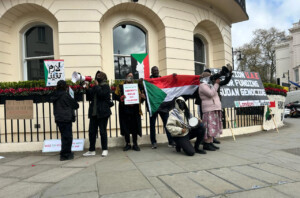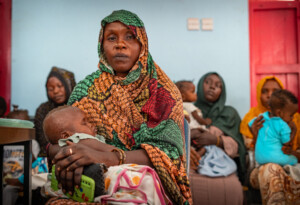Sudan OCHA bulletin 30: Acute Jaundice Syndrome cases in North Darfur
Between 18 and 24 July, 45 new cases of suspected Acute Jaundice Syndrome (AJS) were reported in North Darfur’s Sortony, the UN Office for the Coordination of Humanitarian Affairs (OCHA) in Sudan said in its latest weekly bulletin.
Between 18 and 24 July, 45 new cases of suspected Acute Jaundice Syndrome (AJS) were reported in North Darfur's Sortony, the UN Office for the Coordination of Humanitarian Affairs (OCHA) in Sudan said in its latest weekly bulletin.
The 45 new cases in Sortony, a site hosting people displaced by fighting in Jebel Marra that started in January this year, bring the total to 121 cases since May 2016, including two deaths (both children), according Médecins Sans Frontières-España (MSF-E) and the World Health Organization (WHO).
AJS is an epidemic-prone, water borne disease, with a faecal-oral route of transmission through contaminated water, and can be a symptom of different epidemic-prone diseases, including dengue, hepatitis A or E and yellow fever. AJS outbreaks mostly occur in areas where people live in cramped conditions, with poor water supply and insufficient sanitation and hygiene facilities, such as Sortony.
There are significant health risks arising as a result of over 4,500 livestock living in close vicinity to the displaced people in Sortony. Health Sector and Water, Sanitation and Hygiene (WASH) Sector partners are working with the North Darfur Ministry of Health to address the causes of the Hepatitis E and diarrhoea cases in Sortony by ensuring that all water supplies are chlorinated, providing sanitation and hygiene equipment, and conducting awareness sessions and home visits in the community.
During the first seven months of 2016, close to 81,000 people were newly displaced across Darfur according to the UN and partners. Up to an additional 170,000 people were also reportedly displaced, of whom 50,000 have reportedly returned, but the UN and partners are unable to verify these figures due to a lack of access to the relevant locations. The vast majority of the displacement in 2016 to date was triggered by the conflict in the Jebel Marra area.
Funding shortage for health care in Blue Nile State
The national NGO Pancare is facing funding shortages for its mobile clinics in Blue Nile State, which provide health services for the displaced in the state. If funding is not secured, they may have to suspend operations from August, says the organisation.
Pancare runs the clinics since March this year and targets displaced people living in informal settlements in Roseires locality. Host community clinics, in places where they exist, reportedly lack medical supplies at times, which means that the mobile clinics run by Pancare are essential for the provision of basic healthcare to the displaced in Roseires.
According to verifications and interventions conducted by the World Food Programme (WFP), Unicef, WHO, and the Blue Nile Ministry of Health, there are an estimated 23,000 displaced living in the locality, to whom the mobile clinics provide health care by visiting each site four times per month.
South Sudanese refugees to be relocated
An estimated 89,300 refugees from South Sudan have arrived in parts of Sudan since January 2016, fleeing food insecurity and conflict, of whom almost 55,000 are in East Darfur.
On 20 July 2016, the Sudanese Red Crescent Society (SRCS) and UNHCR started the demarcation of the new site in El Kariyo, 45 kilometres from the East Darfur capital Ed Daein. More than 30,000 South Sudanese refugees living in the Khor Omer camp will be relocated to the new site once it has been fully established. An information campaign is being carried out to inform the refugee community in Khor Omer about the relocation, and UNHCR is planning to take community leaders to explore the new site.
An inter-agency needs assessment conducted in Abu Sinaidira in East Darfur's El Ferdous locality in early July, targeting the estimated 6,000 newly arrived South Sudanese refugees has identified significant gaps in the availability of health care, including essential drugs and medical equipment. Although the East Darfur Ministry of Health has been providing emergency drugs for children under the age of five free of charge, most refugees could not afford medical consultations, treatment or purchase of drugs. Food is also insufficient, with adult refugees reportedly consuming one meal per day.
There are three water stations in the village, of which two need urgent rehabilitation. There are no latrines in the area, and open defecation remains prevalent. The refugees are currently living in an open area without any cover; construction of emergency shelters is urgently needed. Government and humanitarian actors have developed an action plan to address the urgent needs identified across different sectors as soon as possible. WFP and UNHCR have provided food and non-food items to the approximately 6,000 arrivals.
South Sudanese refugees in South Darfur, West Kordofan
Refugees fleeing conflict and food insecurity in South Sudan are also arriving directly in South Darfur, where there are reportedly 5,599 South Sudanese refugees who arrived in 2016. According to the governmental Commission of Refugees (COR), there are an estimated 5,324 refugees in Beleil camp for the displaced near the South Darfur capital Nyala.
It is anticipated that more refugees will arrive in South Darfur. Government representatives from Khartoum including from Federal COR, the Ministry of Interior Affairs, and the National Intelligence and Security Service will visit South Darfur next week to assess the situation and develop a plan to assess the refugees' needs, provide humanitarian assistance, and identify a site for them. An inter-agency mission is planned following the governmental mission.
WFP finalised a verification exercise in El Meiram in West Kordofan, and identified that 4,538 South Sudanese refugees have arrived in 2016. Food distributions will be carried out for them in the coming week.
An inter-agency mission was conducted in Kharasana by UNHCR, OCHA, and Unicef in mid-July and more information will be available after the mission report is finalised.
Flooding continues across Sudan
Heavy rains and flooding have continued in some areas in Sudan, including parts of Blue Nile, Kassala, Khartoum, North, South and West Darfur, Northern, and South and West Kordofan states.
An estimated 42,850 people have been affected so far, according to the Government of Sudan, SRCS and partners, and efforts are ongoing to verify the number of people affected and map their needs and the response. In affected areas, an estimated 8,570 houses have been damaged, of which 4,308 were completely destroyed.
Flooding usually occurs during the rainy season in Sudan, which is from June to October. The government-led response is ongoing at the national level by the National Flood Steering Committee which is comprised of the governmental Humanitarian Aid Commission, Civil Defence and SRCS, and is supported by OCHA.
At the state level, governmental Emergency Committees are finalising flood contingency plans and responding to help people affected by flooding through line ministries and national NGOs. Support from international humanitarian actors is being provided in some states including North Darfur and West Kordofan.
IOM verifying returns in West Darfur
As part of Recovery, Return and Reintegration activities in West Darfur, the International Organization for Migration (IOM) is conducting a verification exercise aimed at providing disaggregated data on displaced and returnees in 156 villages in eight localities where returns have taken place.
According to IOM, 115,653 people returned to their villages of origin in West Darfur between the start of the conflict in 2003 and the end of 2015.











 and then
and then